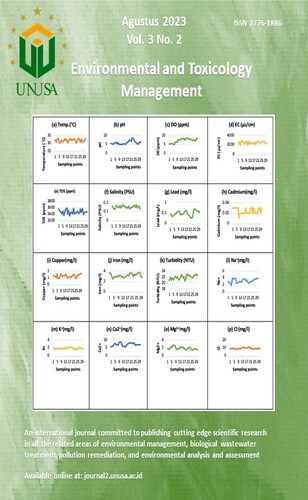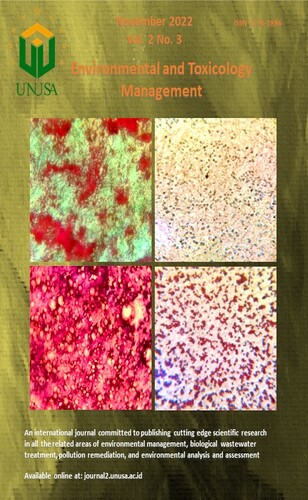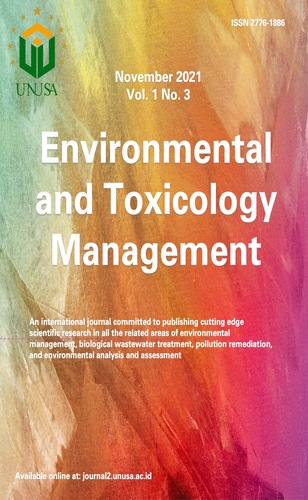About the Journal
Environmental and Toxicology Management is a peer-reviewed journal for the publication of original articles, short communication, review articles, and case studies on the
Current Issue
Vol. 3 No. 1 (2023) Environmental factors and their impacts
This issue focuses on how environmental factors can have a major influence on human health. Communities can reduce exposure of pollutants that have a toxic effect by optimizing environmental health and how several environmental remediation technologies are applied for improving environmental health.
Articles
Phytoremediation of perfluorochemicals: A review of its advances, feasibility and limitations
DOI :
https://doi.org/10.33086/etm.v3i1.3724
1-7
2023-04-30
 Abstract views: 320 ,
Abstract views: 320 ,
 Downloads : 192
Downloads : 192
Abstract
The detection of perfluorochemicals (PFCs) in various environmental compartments has raised attention and driven countermeasures to reduce their prevalence. Phytoremediation provides a feasible option for PFCs removal from the environment. Crops such as maize, carrots, lettuce, tomato and spinach have demonstrated the ability to phytoextract and phytoaccumulate PFCs. The bioconcentration factor
Phytoremediation of perfluorochemicals: A review of its advances, feasibility and limitations
DOI :
https://doi.org/10.33086/etm.v3i1.3724
1-7
2023-04-30
 Abstract views: 320 ,
Abstract views: 320 ,
 Downloads : 192
Downloads : 192
Abstract
The detection of perfluorochemicals (PFCs) in various environmental compartments has raised attention and driven countermeasures to reduce their prevalence. Phytoremediation provides a feasible option for PFCs removal from the environment. Crops such as maize, carrots, lettuce, tomato and spinach have demonstrated the ability to phytoextract and phytoaccumulate PFCs. The bioconcentration factor
 Abstract views: 320 ,
Abstract views: 320 ,
 Downloads : 192
Downloads : 192
Abstract
The detection of perfluorochemicals (PFCs) in various environmental compartments has raised attention and driven countermeasures to reduce their prevalence. Phytoremediation provides a feasible option for PFCs removal from the environment. Crops such as maize, carrots, lettuce, tomato and spinach have demonstrated the ability to phytoextract and phytoaccumulate PFCs. The bioconcentration factor
Environmental factors influencing construction implementation from contractors’ perspective
DOI :
https://doi.org/10.33086/etm.v3i1.4145
8-12
2023-04-30
 Abstract views: 193 ,
Abstract views: 193 ,
 Downloads : 165
Downloads : 165
Abstract
To achieve the project’s goal, both internal and external organization influencing factors (construction industry) should be aware, particularly at the construction implementation level. The objective of this research is to identify the environmental factors that influence construction implementation from the contractor’s perspective as the main actors in the implementation of construction.
Environmental factors influencing construction implementation from contractors’ perspective
DOI :
https://doi.org/10.33086/etm.v3i1.4145
8-12
2023-04-30
 Abstract views: 193 ,
Abstract views: 193 ,
 Downloads : 165
Downloads : 165
Abstract
To achieve the project’s goal, both internal and external organization influencing factors (construction industry) should be aware, particularly at the construction implementation level. The objective of this research is to identify the environmental factors that influence construction implementation from the contractor’s perspective as the main actors in the implementation of construction.
 Abstract views: 193 ,
Abstract views: 193 ,
 Downloads : 165
Downloads : 165
Abstract
To achieve the project’s goal, both internal and external organization influencing factors (construction industry) should be aware, particularly at the construction implementation level. The objective of this research is to identify the environmental factors that influence construction implementation from the contractor’s perspective as the main actors in the implementation of construction.










